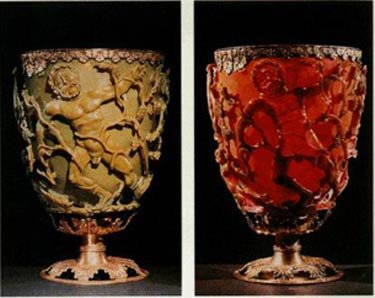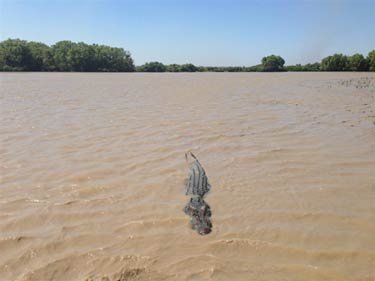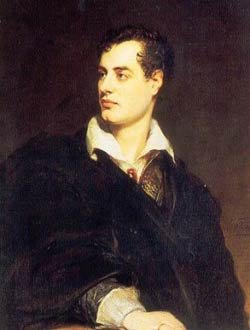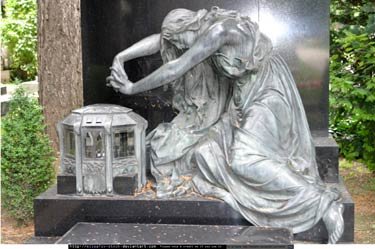Archive for August, 2013
27 Aug 2013


Smithsonian magazine:
The colorful secret of a 1,600-year-old Roman chalice at the British Museum is the key to a superÂsensitive new technology that might help diagnose human disease or pinpoint biohazards at security checkpoints.
The glass chalice, known as the Lycurgus Cup because it bears a scene involving King Lycurgus of Thrace, appears jade green when lit from the front but blood-red when lit from behind—a property that puzzled scientists for decades after the museum acquired the cup in the 1950s. The mystery wasn’t solved until 1990, when researchers in England scrutinized broken fragments under a microscope and discovered that the Roman artisans were nanotechnology pioneers: They’d impregnated the glass with particles of silver and gold, ground down until they were as small as 50 nanometers in diameter, less than one-thousandth the size of a grain of table salt. The exact mixture of the precious metals suggests the Romans knew what they were doing—“an amazing feat,†says one of the researchers, archaeologist Ian Freestone of University College London.
The ancient nanotech works something like this: When hit with light, electrons belonging to the metal flecks vibrate in ways that alter the color depending on the observer’s position. Gang Logan Liu, an engineer at the University of Illinois at Urbana-Champaign, who has long focused on using nanotechnology to diagnose disease, and his colleagues realized that this effect offered untapped potential. “The Romans knew how to make and use nanoparticles for beautiful art,†Liu says. “We wanted to see if this could have scientific applications.â€
When various fluids filled the cup, Liu suspected, they would change how the vibrating electrons in the glass interacted, and thus the color. (Today’s home pregnancy tests exploit a separate nano-based phenomenon to turn a white line pink.)
———————–
The cup’s history via Wikipedia:
The cup was “perhaps made in Alexandria” or Rome in about 290-325 AD, and measures 16.5 x 13.2 cm. From its excellent condition it is probable that, like several other luxury Roman objects, it has always been preserved above ground; most often such objects ended up in the relatively secure environment of a church treasury. Alternatively it might, like several other cage cups, have been recovered from a sarcophagus. The present gilt-bronze rim and foot were added in about 1800, suggesting it was one of the many objects taken from church treasuries during the period of the French Revolution and French Revolutionary Wars. The foot continues the theme of the cup with open-work vine leaves, and the rim has leaf forms that lengthen and shorten to match the scenes in glass. In 1958 the foot was removed by British Museum conservators, and not rejoined to the cup until 1973. There may well have been earlier mounts.
The early history of the cup is unknown, and it is first mentioned in print in 1845, when a French writer said he had seen it “some years ago, in the hands of M. Dubois”. This is probably shortly before it was acquired by the Rothschild family. Certainly Lionel de Rothschild owned it by 1862, when he lent it to an exhibition at what is now the V&A Museum, after which it virtually fell from scholarly view until 1950. In 1958 Victor, Lord Rothschild sold it to the British Museum for £20,000… .The cup is normally on display, lit from behind, in Room 50 (it forms part of the museum’s Department of Prehistory and Europe).
26 Aug 2013


Worldnews NBC:
An Australian camper was missing and presumed dead after being snatched by a crocodile in front of onlookers as he swam across a river with a friend, police told local media Sunday.
The 24-year-old was swimming with a friend on Saturday afternoon near the Mary River Wilderness Retreat, about 80 miles east of Darwin in the country’s Northern Territory.
The pair swam to the middle of the muddy river and were on their way back when the crocodile lunged, taking the victim below the surface, news site NT News reported.
Saltwater crocodiles, which can grow up to 23 feet long and weigh more than a tonne, are a common feature of Australia’s tropical north, Agence France-Presse (AFP) reported.
The local man was celebrating a friend’s 30th birthday at the outback tourist destination, Senior Sergeant Geoff Bahnert told The Associated Press.
“Several of the group in the party witnessed the male being taken in the jaws of the croc for a period of time, and then he was out of sight,” Bahnert said.
“The Mary River is known worldwide to have the greatest saturation of adult saltwater crocodiles in the world. You don’t swim in the Mary River,” he said.
Alcohol may have played a part in the decision to swim, he said.
26 Aug 2013

Hat tip to Clarice Feldman [FB].
26 Aug 2013
 photo: Julie Martin Matheson. photo: Julie Martin Matheson.
Famed retired Orange County huntsman, who still hunts hounds as Master of his own Bath County pack, Melvin Poe celebrated his 93rd birthday with a pre-season trail ride near his home in Hume, Virginia.
25 Aug 2013


Lieutenant Colonel John Malcolm Thorpe Fleming “Jack” Churchill, DSO & Bar, MC & Bar (16 September 1906 – 8 March 1996), nicknamed Fighting Jack Churchill and Mad Jack, was a British soldier who fought throughout the Second World War armed with a longbow, and a Scottish broadsword. He was known for the motto “any officer who goes into action without his sword is improperly armed.”
Wikipedia:
In May 1940 Churchill and his unit, the Manchester Regiment, ambushed a German patrol near L’Epinette, France. Churchill gave the signal to attack by cutting down the enemy Feldwebel (sergeant) with a barbed arrow, becoming the only British soldier known to have felled an enemy with a longbow in WWII. After fighting at Dunkirk, he volunteered for the Commandos.
Churchill was second in command of No. 3 Commando in Operation Archery, a raid on the German garrison at Vågsøy, Norway on 27 December 1941. As the ramps fell on the first landing craft, Churchill leapt forward from his position and played a tune on his bagpipes, before throwing a grenade and running into battle in the bay. For his actions at Dunkirk and Vågsøy, Churchill received the Military Cross and Bar.
In July 1943, as commanding officer, he led 2 Commando from their landing site at Catania in Sicily with his trademark Scottish broadsword slung around his waist, a longbow and arrows around his neck and his bagpipes under his arm, which he also did in the landings at Salerno. Leading 2 Commando, Churchill was ordered to capture a German observation post outside of the town of La Molina, controlling a pass leading down to the Salerno beach-head. He led the attack by 2 and 41 Commandos, infiltrated the town and captured the post, taking 42 prisoners including a mortar squad. Churchill led the men and prisoners back down the pass, with the wounded being carried on carts pushed by German prisoners. He commented that it was “an image from the Napoleonic Wars.” He received the Distinguished Service Order for leading this action at Salerno.
In 1944 he led the Commandos in Yugoslavia, where they supported Josip Broz Tito’s Partisans from the Adriatic island of Vis. In May he was ordered to raid the German held island of BraÄ. He organized a “motley army” of 1,500 Partisans, 43 Commando and one troop from 40 Commando for the raid. The landing was unopposed but on seeing the eyries from which they later encountered German fire, the Partisans decided to defer the attack until the following day. Churchill’s bagpipes signalled the remaining Commandos to battle. After being strafed by an RAF Spitfire, Churchill decided to withdraw for the night and to re-launch the attack the following morning. The following morning, one flanking attack was launched by 43 Commando with Churchill leading the elements from 40 Commando. The Partisans remained at the landing area; only Churchill and six others managed to reach the objective. A mortar shell killed or wounded everyone but Churchill, who was playing “Will Ye No Come Back Again?” on his pipes as the Germans advanced. He was knocked unconscious by grenades and captured.[9] He was later flown to Berlin for interrogation and then transferred to Sachsenhausen concentration camp.
In September 1944 Churchill and a Royal Air Force officer crawled under the wire, through an abandoned drain and attempted to walk to the Baltic coast. They were captured near the coastal city of Rostock, a few kilometres from the sea. In late April 1945 Churchill and about 140 other prominent concentration camp inmates were transferred to Tyrol, guarded by SS troops. A delegation of prisoners told senior German army officers they feared they would be executed. An army unit commanded by Captain Wichard von Alvensleben moved in to protect the prisoners. Outnumbered, the SS guards moved out, leaving the prisoners behind. The prisoners were released and after the departure of the Germans, Churchill walked 150 kilometres (93 mi) to Verona, Italy where he met an American armoured force.
As the Pacific War was still on, Churchill was sent to Burma, where the largest land battles against Japan were being fought. By the time Churchill reached India, Hiroshima and Nagasaki had been bombed and the war ended. Churchill was said to be unhappy with the sudden end of the war, saying: “If it wasn’t for those damn Yanks, we could have kept the war going another 10 years.
25 Aug 2013


Lord Byron
Percy Bysshe Shelley on Lord Byron’s lifestyle.
Lord Byron gets up at two. I get up, quite contrary to my usual custom… at twelve. After breakfast we sit talking till six. From six to eight we gallop through the pine forest which divides Ravenna from the sea; we then come home and dine, and sit gossiping till six in the morning. I don’t suppose this will kill me in a week or a fortnight, but I shall not try it longer. Lord B.’s establishment consists, besides servants, of ten horses, eight enormous dogs, three monkeys, five cats, an eagle, a crow, and a falcon; and all these, except the horses, walk about the house , which every now and the resounds with their unarbitrated quarrels, as if they were the masters of it… .[P.S.] I find that my enumeration of the animals in this Circean palace was defective… .I just met on the grand staircase five peacocks, two guinea hens, and an Egyptian crane. I wonder who all these animals were before they changed into these shapes.
Via Ratak Mondosico.
24 Aug 2013


Parachutiste Francais forwarded the above photo with the caption:
UN BEL HOMMAGE POUR UN VRAI HÉROS !
Ce chien s’appel Zanjeer.
Il a sauvé des millers de vies pendant la série d’attentats à Bombay en Mars 1993 en détectant plus de 3,329 kgs d’explosifs RDX, 600 détonateurs, 249 Grenades à main et 6406 sous munitions.
Il a été enterré avec les honneurs.
—————————
trans.
A fitting homage for a true hero.
The dog was named Zanjeer [meaning “metal chain” in Persian].
He saved thousands of lives following a series of attacks in Bombay in March 1993 by detecting 3,329 kg. of RDX explosive, 600 detonators, 249 hand grenades, and 6406 rounds of live ammunition.
He was buried with honors.
—————————
Zanjeer (1992-2000) was a Golden Labrador who worked as a bomb detecting dog for the Bombay Police. He died of cancer in 2000 at age 8, and was buried with full honors by the Bombay Police.
The above photograph began going viral last March around the time of the twentieth anniversary of the Bombay attacks.
HuffPo ran a story at the time.
24 Aug 2013


Detail from Fra Angelico, St. Nicholas Giving Gold to the Three Poor Girls, 1437, Città del Vaticano, Pinacoteca.
SlumberWise explains that people used to sleep differently in Olden Times.
[W]e didn’t always sleep in one eight hour chunk. We used to sleep in two shorter periods, over a longer range of night. This range was about 12 hours long, and began with a sleep of three to four hours, wakefulness of two to three hours, then sleep again until morning.
References are scattered throughout literature, court documents, personal papers, and the ephemera of the past. What is surprising is not that people slept in two sessions, but that the concept was so incredibly common. Two-piece sleeping was the standard, accepted way to sleep.
“It’s not just the number of references – it is the way they refer to it, as if it was common knowledge,†Ekirch says.
An English doctor wrote, for example, that the ideal time for study and contemplation was between “first sleep†and “second sleep.†Chaucer tells of a character in the Canterbury Tales that goes to bed following her “firste sleep.†And, explaining the reason why working class conceived more children, a doctor from the 1500s reported that they typically had sex after their first sleep.
Ekirch’s book At Day’s Close: Night in Times Past is replete with such examples.
But just what did people do with these extra twilight hours? Pretty much what you might expect.
Most stayed in their beds and bedrooms, sometimes reading, and often they would use the time to pray. Religious manuals included special prayers to be said in the mid-sleep hours.
Hat tip to Ann Rice [via FB].
24 Aug 2013


Female sculpture from Zentralfriedhof Cemetery, Simmering, Vienna (click on picture for larger image)
My curiosity is insatiable once provoked, and I’ve just wasted more than a hour trying to figure out whose memorial this very charming statue ornaments, and what is intended by the image of a classically-draped Bernini-esque female figure, kneeling, long hair hanging down, wringing her hands over a peculiar Art Noveau jewelry box or miniature model of a theater. Are we to take it that the soul or anima of the deceased is housed in this rock-crystal-windowed casket and the lady is imploring for it to come back to life?
A statue of this quality and interest is bound to be photographed more than once, and sure enough, I found more details at least, here and here. But none of the photographers can be bothered to identify the deceased party being memorialized, the sculptor, or what exactly is supposed to be going on. Imagine my frustration.
Via Fred Lapides (who means to say “Memento Mori”).
/div>

Feeds
|
